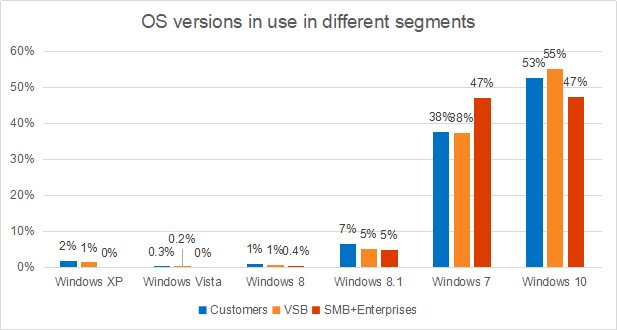Many consumers and businesses still rely on unsupported or near end-of-life operating systems (OS), according to Kaspersky research.
While newer versions of such OS are available, around 41% of consumers still use either an unsupported or approaching end of support desktop OS like Windows XP or Windows 7. At the same time, 40% of very small businesses (VSBs) and 48% of small, medium-sized businesses (SMBs) and enterprises still rely on these systems. This situation creates a security risk.
In most cases, the end of lifecycle of an OS means that no further updates will be issued by the vendor, and this includes updates related to cybersecurity. Yet security researchers or cyberattackers may find previously unknown vulnerabilities within these systems. Subsequently, these vulnerabilities may be used in cyberattacks and users will be left exposed as they will not receive a patch to resolve the issue. To try and gauge how many of these at-risk systems exist in order to estimate the scale of the risk, Kaspersky researchers analyzed the anonymized data of OS use provided by Kaspersky Security Network users (with their consent). The results show that four out of 10 consumers still use obsolete systems, including extremely old ones like Windows XP and Vista.
Looking at the specific versions of outdated OS used, two percent of consumers and one percent of workstations used by VSBs rely on Windows XP – an OS which hasn’t been supported for over 10 years. Less than half a percent of consumers (0.3%) and VSBs (0.2%) still prefer Windows Vista, for which mainstream support ended seven years ago. Remarkably, some consumers (1%) and businesses (0.6% of VSBs and 0.4% of SMBs and enterprises) missed the free update to Windows 8.1 and continue to use Windows 8, which has not been supported by Microsoft since January 2016.

The distribution of Windows OS versions on desktop devices used by consumers and business customers
Windows 7 is still a popular choice for consumers and businesses, despite extended support coming to an end in January 2020. More than a third (38%) of consumers and VSBs, and 47% of SMBs and enterprises, still run this OS. For the small, medium-sized and enterprise business segments, the share of Windows 7 and the newest version of Windows 10 (47% of workstations work on this OS) is the same.
“Statistics show that a significant share of users, both businesses and individuals, still use workstations running an outdated or approaching end of lifecycle OS. The widespread use of Windows 7 is concerning, as there is less than six months to go until this version becomes unsupported. The reasons behind this lag vary depending on the software in place, which may be unable to run on the newest OS versions, to economic reasons and even just down to habit. Nonetheless, an old unpatched OS is a cybersecurity risk – the cost of an incident may be substantially higher than the cost of upgrading. This is why we recommend that customers migrate to supported versions and ensure that additional security tools are in place during the transition period.” – Alexey Pankratov, Enterprise Solutions Manager, Kaspersky.
To be protected against emerging threats, Kaspersky recommends that businesses and consumers do the following:
- Use an up-to-date version of the OS with the auto-update feature enabled
- If upgrading to the latest OS version is not possible, organizations are advised to take into account this attack vector in their threat model and to address it through smart separation of vulnerable nodes from the rest of the network, in addition to other measures. Consider Kaspersky Embedded Systems Security (if using Windows XP)
- Use solutions with behavior-based exploit prevention technologies, such as Kaspersky Security Cloud, Kaspersky Endpoint Security for Business, and Kaspersky Small Business Security which help to reduce the risk of exploits targeting obsolete OS (Windows 7 and later)
About Kaspersky
Kaspersky is a global cybersecurity company founded in 1997. Kaspersky’s deep threat intelligence and security expertise is constantly transforming into innovative security solutions and services to protect businesses, critical infrastructure, governments and consumers around the globe. The company’s comprehensive security portfolio includes leading endpoint protection and a number of specialized security solutions and services to fight sophisticated and evolving digital threats. Over 400 million users are protected by Kaspersky technologies and we help 270,000 corporate clients protect what matters most to them. Learn more at www.kaspersky.com.
